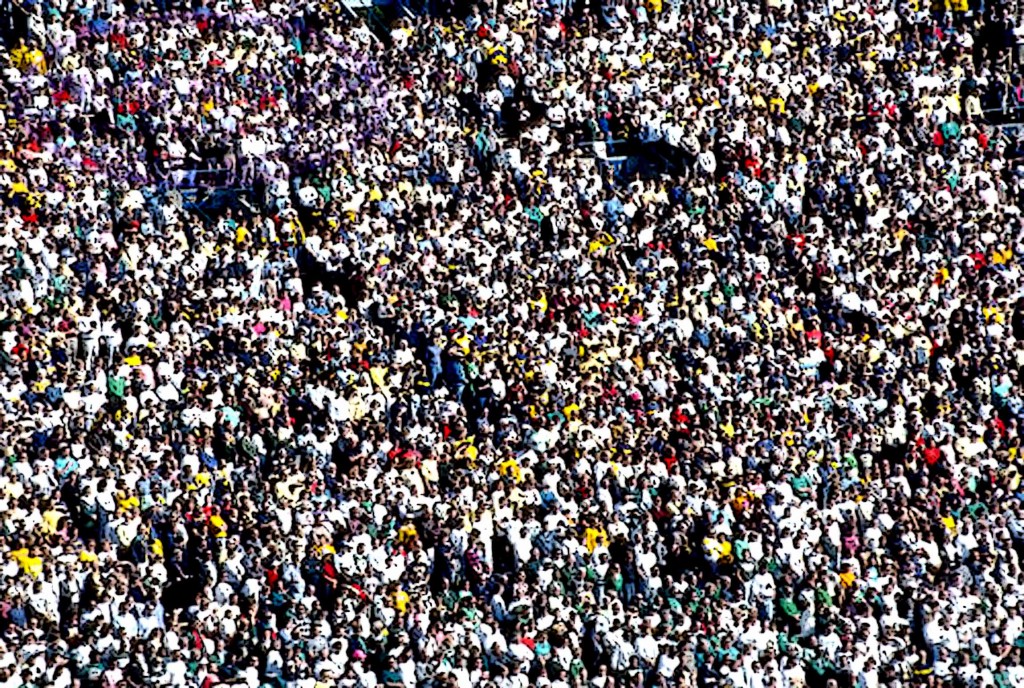DAY of SEVEN BILLION
by Kathleene Parker
The United Nation’s choice of October 31, 2011, as the “Day of Seven Billion”—the day when Earth will attain a population of 7 billion—is spooky beyond just its falling on Halloween.

But the hallmark—on a planet with fewer than 2.5 billion when this baby boomer was born—is a chance to address the myth that the problem isn’t overpopulation, it is overconsumption. Actually, it is both. I’ll also talk about what I call the Population Religion, with its dogma and use of language.
If there is anything spookier than the Halloween date, it is that Big Media and big economic forces, by early summer, were already busy telling us that (1.) population growth is nothing to worry about, (2.) the real problem is a lack of babies, the absurdity—on a planet gaining 78 million people a year—of the “birth dearth”; and the absurdity (3.) that population will somehow magically stabilize mid-to-late century—sort of a demographic version of Gone With the Wind’s Scarlet O’Hara’s, “I can’t think about that right now. I’ll worry about it tomorrow.”
It’s a good delaying tactic, especially when there are so many “more urgent” priorities. But, many of those, such as a crumbling economy, are linked to increased competition for fixed resources, especially the critical underpinnings of every economy on the planet, energy.
And, most critical, tomorrow’s population is determined today. We can’t get out to 2049 and decide there are too many people. By then, it will be too late for what should have been done last century:
* global policies to stabilize population through strictly voluntary means contraceptives made available, free, to everyone of reproductive age who wants them, including in countries, such as the Philippines, where birth control is illegal, or Madagascar, a treasure trove of rare species being decimated by population growth, but where women who have not had a child are denied contraceptives.
* a population policy for our own nation, both to lead by example and to guide decisions on population-influencing forces, such as immigration.
As an aside, I oppose China’s draconian and coercive “one child” policy. It is brutal and morally and intellectually indefensible. Worse, thanks to the media’s almost universally negative reporting of it—likely rooted in agendas of economic “elites” who own and control our media and who want population growth kept high—everyone assumes that China’s approach is the only way to slow growth.
Absurd! The most effective programs dangle a carrot but rarely a stick. They (1.) appeal to peoples’ patriotism, as did Iran, (2.) offer financial and other incentives for small families and, in extreme cases, economic disincentives against large families, and (3.) focus on education, such as soap operas that portray young, together women in other than traditional child-bearing roles. (www.populationmedia.org) That approach contributed, for example, to Mexico’s plummeting birth rate late last century. It is now being used in other population hot spots, in areas lacking television, via radio soap operas. (It is baffling, that the United States, the world’s third most populated and fourth fastest growing nation, offers tax credits, arguably incentives, for each child added to a family, but it is also baffling that the U.S. Census Bureau blatantly deceives about both our birth rate and our growth rate, both of which are high. And, as another aside, the American West for five decades or more has grown at Third World rates of 2 to 3 percent a year, Nevada, at one time, topped out at a ghastly 5 percent a year, the fastest growing “nation” in the world at the time!)
As media forces this summer geared up for the “Day of Seven Billion,” they soothingly predicted population stabilization at 8 billion later this century. Others think 11 billion, others worry about 15 billion, but so many variables affect population that projections decades out are little more than wild guesses.
I believe global population will stay below 9 billion, because brutal forces linked to rising energy costs, food and water shortages and increasing disease in the planet’s increasing—in size and frequency—“mega cities” will escalate disease and starvation. Global warming will likely compound both. Nature, in short, will do as Norman Borlaug, who pioneered the Green Revolution warned, it will deal with the problem and “Nature’s way is never very kind.” Sadly, the world’s poor will suffer most from a problem the First World has steadfastly refused to acknowledge or address.
And, Big Media, this summer, didn’t mention that Mother Earth—in the midst of the biggest species extinction since the die off of the dinosaurs—is “blessed” with the arrival of an additional 78 million homo sapiens annually, why every 12 years or so the population odometer ratchets up another billion. We were at a “mere” 4 billion in 1974, 5 billion in 1988, 6 billion in 1999 (as the U.S. media focused almost solely on the birth dearth, the route it seems it will take this time too) and now 7 billion!
On the rare occasions when the media focus on population, it seems to be with an “always room for more” theme, ignoring that it is not space that limits population. People—as long as technology and energy allow food and water to stream into cities—can live like sardines in a can. It is water (a growing global crisis) and food, frighteningly linked to energy (another growing crisis as recent food riots showed). Nor do the media acknowledge that there are other “Earthlings,” the thousands of plant and animal species increasingly being squeezed to the margins or over the precipice by human population pressures or global warming, itself linked to population. Do we really want to continue into what some call the “Anthropocene Era”? The name of our new age couched in scientific recognition that humans changes upon the planet equate with the most powerful of geological forces. Others say we’re entering the “Age of Solitude,” when humankind alone will inhabit the planet, but of course, that would lead to our own extinction too.
Which brings me to overpopulation versus overconsumption. I have often noted how the most “green” individual nonetheless eagerly defends population growth even as they agonize about an environment in freefall, grieve for dying species and worry about global warming in the face of what famous environmental activist and author Dave Foreman calls, “Man Swarm.”
If we were the mere 2.3 billion people we were the year I was born, over consumption would not be the issue it is at 7 billion. But, those who see “doing with less,” as a solution, need to realize that under a global economic system predicated on endless growth and consumption, “wise use” and “conservation” merely diverts conserved resources to subsidize growth. We see that in the Southwest where water conserved merely flows into new subdivisions and developments.
Studies have examined how many humans Earth can sustain, based on data about known resources, many of them finite. These show that we are “using” about 1.5 Earths, worrisome since we only have 1.0 Earths and no replacements or add-ons available. Today’s growth is fed by “mining,” or drawing down, resources, such as water—in aquifers that took thousands of years to accumulate—or irreplaceable mineral reserves, that really belong to our children and grandchildren.
David Pimentel, Professor Emeritus of Cornell’s Department of Ecology, determined that, long-term, Earth can sustain only 2 billion of us. As to doing with less, how much less? If we opt for a Bangladeshi lifestyle, Mother Earth will be able to provide for a few more of us, long term; fewer still if we opt for, say, a rural Eastern European lifestyle. But if strive for a global lifestyle that makes Wall Street drool with greedy anticipation, a United States lifestyle—even a 1950s United States lifestyle—things are going to do exactly what they have begun to do: go south fast, first, as we’re seeing, for non-human Earthlings, then the poor and then for everyone. And that’s at 2 billion or 3 billion, never mind 7 billion. We’re particularly seeing that as China transforms to an industrial standard of living for its 1.3 billion citizens, an effort that is sending environmental and economic shockwaves around the globe, for example as China buys millions of acres of Africa—at the expense of indigenous people and wildlife—to convert to farmland.
As Thomas Friedman said in, “The Earth is Full,” a recent New York Times op/ed, “This is not science fiction. This is what happens when our system of growth and the system of nature hit the wall at once….”
Even a 1,000 square foot house (my average-sized tract home is 1,770 square feet), with a Prius in the driveway, a flat-screen TV and a washer, drier and central heating is not, by the standards of a planet in freefall, “green” or “sustainable,” a word which, when coupled with the word “growth,” becomes my favorite oxymoron.
Portland, Oregon is the epitome of that oxymoron. Despite the “greenness” for which it is famous and despite millions invested, it continues to sprawl across ever-more Oregon countryside. As one journalist pointed out, they could have reduced their carbon footprint more, at no cost, by keeping 50 people from moving there or by discouraging the birth of 50 children!
That brings me to the Growth Religion and its growth language.
Population growth was needed in the year 1600; it is not in 2011. Yet, we—especially economists and corporate media—still look at it through 1600 eyes. Their reporting is prejudiced in its favor on one hand, on the other wears blinders to its downside. For example, recent reports of global disasters ignore the part population played or is playing in each:
That the civil war in Rwanda had its original roots in explosive population growth and agricultural collapse.
That Haiti was, long before the earthquake, a population disaster area. Pre-earthquake images from space showed a ravaged countryside contrasting with the lushness of the adjoining Dominican Republic.
That the civil-war rooted disaster in Somalia is also a population disaster, if by no other measure than that trooping across miles of drought-blistered landscape are women with 5, 6, 7, 8, 10 children in tow. Are we unable to grasp how different their circumstances if each had only 2 children?
That perhaps the reason we are having more frequent and more catastrophic natural disasters is that with the Earth’s current high population it is inevitable that more people are in the path of any given tsunami, earthquake, tornado or flood.
That the dialog is denied, as was illustrated recently on CBS’ “Sunday Morning,” when a woman asked rhetorically where all the people were coming from who were moving to her town. Well, if the planet adds 78 million and the nation adds 3 million a year, if Utah population increases by a whopping 24 percent as it did between 2000 and 2010, isn’t it obvious?
And then there’s language. Our love of population growth is like religious dogma, so we structure language, our very way of thinking, accordingly. Our highways aren’t too crowded, they’re “inadequate.” Strange, the same highway was perfectly adequate 20 years ago! The Southwest endures “water shortages,” yes, driven by drought, but it also suffers, as the fastest growing region in the world’s 4th fastest growing nation, a “longage of people”—words never used. We hear of a “shortage of doctors,” with no acknowledgement that a Presidential Commission in 1972 warned that problem if our nation reached the 300 million-plus Americans we now are. We say “the land has been transformed.” How? Magic? Or, by our numbers, in combination with a non-sustainable economic system, in a pattern and in a way some have seen as similar to how cancer spreads through its host.
So, yes, there is a lot that’s spooky about the “Day of 7 Billion,” most especially that—like a Victorian-era family with a befuddled relative secreted in the attic—we just try to ignore population.
(Parker, a journalist, population activist and native of the Four Corners area, lives near Albuquerque and writes on water, forestry and population issues.)
To read the PDF version of this article, click here: oct11-28-29
Don’t forget our faithful Backbone supporters!





Parker suggests that “Population growth was needed in the year 1600.” — however the resource depletion caused by human expansion has been underway for a much longer time than Parker acknowledges.
It may be reasonable to suggest that human population overshoot of basic solar energy-fueled ecological carrying capacity began as soon as cultivation agriculture began the non renewable draw-down of arable soil productivity by the destruction of tight-rooted perennial forest and prairie species assemblages (MOVING OUT ON THE LIMB OF VULNERABILITY TOWARD RESOURCE EXHAUSTION), by migration to new lands as soil productivity was exhausted(MOVING FURTHER OUT ON THE LIMB OF VULNERABILITY TOWARD RESOURCE EXHAUSTION), and more recently by augmenting solar energy with temporarily available fossil fuels (MOVING AWAY OUT ON THE LIMB OF VULNERABILITY TOWARD RESOURCE EXHAUSTION). Soil degradation is starting
to catch up to us, and there are no more lands to migrate to —- even as we anticipate the growing scarcity of the fossil fuels that we have relied on to drive the most recent ~200 year exponential population and economic expansion.
John Feeney’s essay deals with our very long-term (10,000 year) shaky relationship with the ecosystems upon which we are completely
dependent as he suggests that massive population reduction is now away overdue, see:
‘Agriculture: Ending the world as we know it’
at:
http://www.canyoncountryzephyr.com/newzephyr/august-september2010/html/aug10-20.htm
This essay deals with the reality of the human condition, and how our willingness to destroy natural ecosystems, with our population and economic expansion for the last 10,000 years has brought us to the point where serious population reduction (planned or orchestrated by resource scarcity) is now inevitable in our future.
Peter Salonius